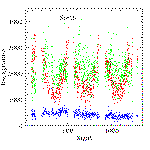
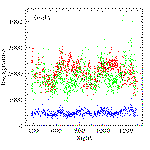
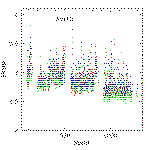
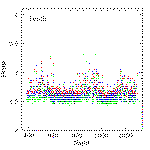
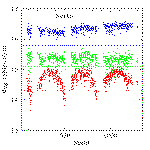
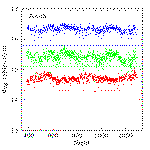
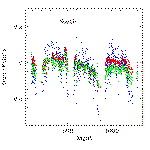
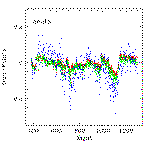
The repeated observations of calibration fields (cf. III.2.c) allow the long term 2MASS site characterstics to be monitored. The figures in this section are based upon the nightly average of all calibrator scans during photometric periods. Night 1 is defined as 1997 March 1 UT. The J, H, and Ks data are shown as blue, green, and red respectively.
i. Backgrounds
Figure 1 shows the strong seasonal dependence of the Ks backgrounds at the Mt. Hopkins facility. The Ks background is dominated by thermal emission of the atmosphere. The gaps of Night 154-187, 507-565, and 872-927 correspond to shutdowns during the Arizona monsoon season. The H backgrounds are dominated by airglow (OH) emission. They show considerably more night-to-night variation, and variations within a night can be more than a factor of two. For the purpose of monitoring long-term trends, data taken with the new H array (starting on night 927) have been multiplied by 1.3 to account for the lower quantum efficiency of the new array. (None of these data are in the Second Incremental Release.)
Figure 2 shows the CTIO backgrounds. CTIO has less seasonal variations in the Ks background.
ii. Image Quality
The best images for the Mt. Hopkins facility from 1997 to 1999 have ~2.7´´-2.8´´ FWHM, as shown in Figure 3. The camera pixels are 2´´. Image sharpness, particularly at Ks, improved after telescope adjustments were made at the end of the 1998 monsoon season (Night 565). The FWHM increases during the summer, which may be a combination of the atmospheric conditions and the poorer focus behavior for the Mt. Hopkins telescope at high temperatures. Adjustments made at the end of the 1999 monsoon further improved the image quality. The CTIO facility (Figure 4) consistently achieves ~2.5´´-2.7´´ FWHM.
iii. Sensitivity
The achieved signal-to-noise ratio (SNR) for faint stars depends primarily upon the background and image sharpness. The 2MASS Level 1 Science Requirements are SNR=10 at 14.3 at Ks, 15.1 at H, and 15.8 at J. Analysis of repeat observations of the calibrator fields has been used to determine empirical correlations describing the magnitude at which SNR=10 is achieved as a function of background and the image sharpness. These correlations are used during the Quality Assessment grading. Figure 5 (Mt. Hopkins) and Figure 6 (CTIO) show the estimated magnitudes appropriate for SNR=10 for each night. The combination of high backgrounds and poor seeing compromises the Mt. Hopkins July data at Ks band; the Mt. Hopkins data taken during the winter is typically 0.6 mag deeper. On average, the H data is better than the specification, but portions of nights with high airglow can be compromised. The J sensitivity nearly always achieves SNR=10 at J>16. The CTIO facility shows less extreme seasonal variations for the Ks band, but can also suffer from high airglow.
iv. Zero-Point Offsets
The zero-point offsets are derived from the night photometric calibration (c.f. IV.8) , and measure the relationship between flux and camera counts(DN). This is a measure of atmospheric transparency and system throughput. More positive zero-points are more sensitive, in the sense that there are more counts for a given flux. Figure 7 and Figure 8 show that the J zero-point varies more strongly on a night-to-night basis than H or Ks at both facilities. This is consistent with the observation that within a photometric night, a constant zero-point is an adequate description of the H and Ks data, while a zero-point that varies linearly with time is needed for the J data. The zero-points show evidence that the atmosphere at Mt. Hopkins is less transmissive near the monsoon season, consistent perhaps with the high humidities and resulting water absorption. The jumps in the CTIO zeropoints are associated with cleaning the camera window and washing the primary mirror of the telescope.

|

|

|
 |
| Figure 1 | Figure 2 | Figure 3 | Figure 4 |

|

|

|
 |
| Figure 5 | Figure 6 | Figure 7 | Figure 8 |